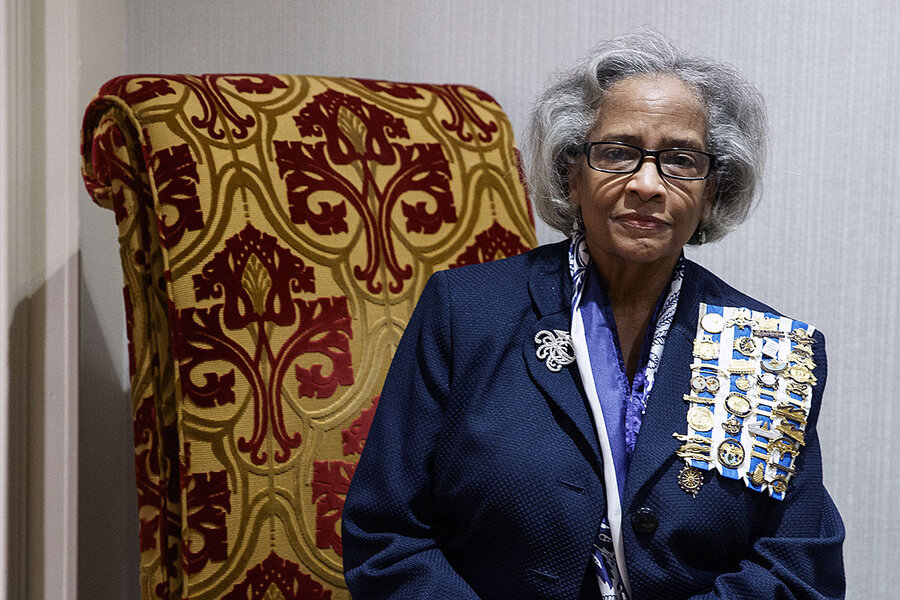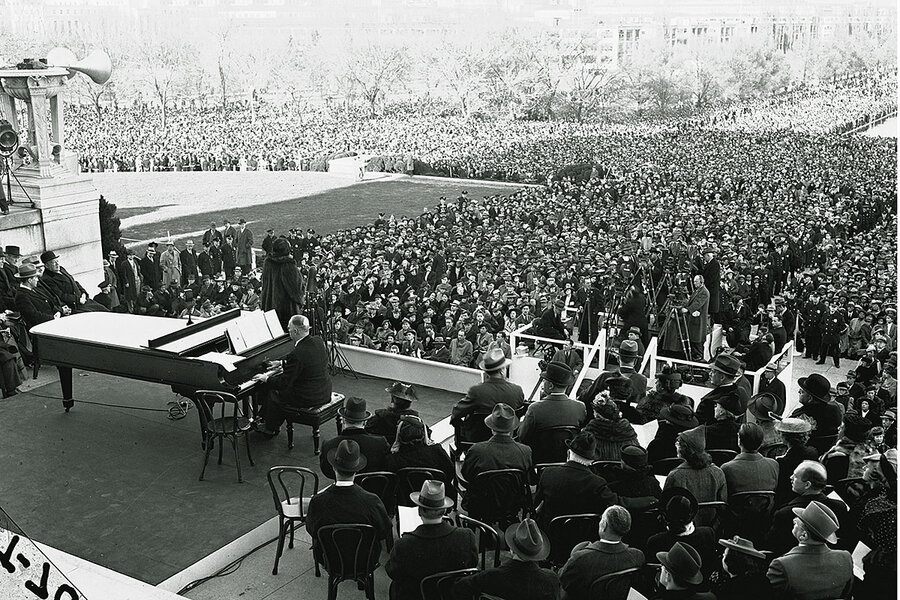Who’s a Daughter of the American Revolution? Answer grows more diverse.
Loading...
At a time when American history is deeply politicized, the Daughters of the American Revolution (DAR) seems committed not only to expanding the country’s understanding of those who participated in the Revolutionary War, but also to shedding the stereotype of being a white, Anglo-Saxon organization.
For decades after its founding in 1890, however, that stereotype seemed true. There was little, if any, acknowledgment that people of color could have ancestors who helped America achieve independence.
Why We Wrote This
Over the last 40 years, the Daughters of the American Revolution has broadened its membership and historical research. These shifts may hold lessons for a more accurate, inclusive view of U.S. history overall.
Then, the first Black member of the modern DAR joined in 1977, and in 1984, the organization explicitly banned discrimination on “the basis of race or creed” after a Black applicant named Lena S. Ferguson was denied membership by a Washington, D.C., chapter. The group now has approximately 190,000 members, and Black Daughters say it’s easy to find people who look like them at big DAR events.
Furthermore, members’ research keeps surfacing a diverse group of patriots. One woman is exploring potential patriots from Mexico, and new Daughters from Louisiana’s Cane River Creole community recently joined.
According to DAR President Denise Doring VanBuren, the organization has two important jobs today: to continue honoring known patriots and to do a better job finding patriots of color and sharing their stories.
When Michelle Wherry joined the Daughters of the American Revolution (DAR), she wasn’t trying to make a statement. She simply thought it was a perfect way to honor her mother, who always said that she and her sisters came from a free Black line.
In the decade since, Mrs. Wherry’s DAR activities have received national attention, in large part because she and many of her friends in the organization don’t fit a stereotype long associated with the 131-year-old society for people whose ancestors helped America achieve independence. “When you think about DAR, you think about white, Anglo-Saxon Protestants,” Mrs. Wherry says. “And here you have women who are ... not what you think of as DAR. But they very much are.”
That’s more true now than ever. DAR’s membership has grown every year since 2007; it now has approximately 190,000 members throughout the United States and around the world. DAR has never tracked data on members’ ethnicity, but Black Daughters say it’s easy to find people who look like them at the organization’s annual Continental Congress and state events.
Why We Wrote This
Over the last 40 years, the Daughters of the American Revolution has broadened its membership and historical research. These shifts may hold lessons for a more accurate, inclusive view of U.S. history overall.
At a time when American history is deeply politicized, DAR seems committed not only to shaking its WASPy reputation, but also to expanding the country’s understanding of those who participated in the Revolutionary War. In fact, DAR’s diverse membership and its ongoing historical preservation work may offer a template for rethinking America’s origin story, and ultimately reveal a different side of patriotism – one that values a variety of voices and is unafraid of digging deeper into the nation’s shared past.
“Patriotism is taking an active role in making sure your country is portrayed in a truthful and honest and positive light,” says Nikki Williams Sebastian, a genealogist who joined DAR in 2014. “Being truthful is not a bad thing. ... History without documentation is mythology. And we have a lot of mythology in this country.”
In a move away from mythology, leaders created the E Pluribus Unum Education Initiative in 2020, which seeks to identify and promote patriots who’ve been left out of the popular historical narrative. The project includes a Patriots of Color database and exhibition titled “Remembrance of Noble Actions: African Americans and Native Americans in the Revolutionary War.”
Earning its reputation
The DAR was founded in 1890, after the Sons of the American Revolution refused to allow women to join its ranks. Initial recruits included more than 700 “Real Daughters” whose fathers had fought in the American Revolution, and members were eager to promote historical preservation, education, and patriotism.
In its early decades, DAR also served to distinguish members from the immigrant populations entering their communities.
“Those 1920s immigration restrictions had a real racist dimension to them,” says Francesca Morgan, author of “A Nation of Descendants” and an associate professor of history at Northeastern Illinois University. “So the ability to document yourself that far back and to claim a patriotic mantle at the same time had tremendous appeal.”
DAR “veered between civic and ethnic nationalism,” says Simon Wendt, an associate professor of American studies at Goethe University Frankfurt and author of “The Daughters of the American Revolution and Patriotic Memory in the Twentieth Century.” They were also an overtly political organization, he adds.
“They branded immigration a threat to the nation and rejected the civil rights movement in the 1950s and 1960s,” says Professor Wendt. “These things are very much in line with mainstream conservative thinking in the 20th century.”
In the later half of the century, Congress tightened laws limiting the political activities of nonprofits. At the same time, some DAR members started challenging racism within the organization. The first Black member of the modern DAR joined in 1977, and in 1984, the organization had to rewrite its bylaws to explicitly ban discrimination on “the basis of race or creed” after a Black applicant named Lena S. Ferguson was denied membership by a Washington, D.C., chapter.
In recent years, the national organization has largely stayed out of conversations that could be deemed political, including debates over monuments of colonial figures or the 1619 Project.
Last summer, amid movements across the country promoting racial and socioeconomic justice, the National Society released a statement reaffirming the organization’s commitment to equality. The brief message reads in part, “We know that examining history helps us to better understand our nation’s long struggle to provide equality, justice and humanity for all Americans. … Bias, prejudice and intolerance have no place in the DAR or America.”
On a national level, President Denise Doring VanBuren says the DAR has two important jobs today: to continue honoring known patriots – “warts and all” – and to do a better job finding patriots of color and sharing their stories.
“We believe that as the descendants of these men and women, we have to be their voice, and we have to support and perpetuate the memory of what they achieved on behalf of our nation,” she says. “We’re kind of the human bridge between the patriots of the American Revolution and the generations that will follow.”
Family and country
Many DAR journeys begin with a desire to iron out a family tree. It’s not easy to get a stamp of approval from DAR’s genealogy board, but for some, that validation motivates them to get through hours upon hours of research.
Mrs. Wherry’s involvement with DAR has provided “great memories” of collaborating with her sisters, she says, one of whom died in 2019. But her participation also reflects a clear desire to set the historical record straight. When she had the opportunity to purchase a tree along a trail in Valley Forge National Historical Park as part of DAR’s Pathway of the Patriots campaign, she wanted it to stand for more than Ezekiel Gomer, her sixth great-grandfather who’d joined the rebellion in 1777. Instead, she dedicated her tree to all the “men, women and children of African heritage who were part of the American Revolution,” including individuals like Sally St. Clair, who disguised herself as a man to join the Continental Army.
Mrs. Sebastian, the genealogist, shares this sense of duty. More than 5,000 Black men, free and enslaved, served in the Continental Army, often for much longer periods than their white counterparts. “I want everyone to remember Black history is American history,” she says.
However, Mrs. Sebastian entered DAR through a white patriot, and like other Black Daughters, her story involves a forced relationship between an enslaved woman and the men who owned her.
Rethinking the Revolution
Edward Barrett, a plantation owner from North Carolina, was already in the DAR’s patriot database when Mrs. Sebastian started investigating her family’s history, she explains in an episode of the “Daughter Dialogues.” Mrs. Sebastian’s family used DNA testing to prove they were related to Barrett through Ellen Johnson-Mathews-Fisher, who was enslaved by Barrett’s grandson and bore his children during the 1860s.
Stories like Mrs. Sebastian’s highlight the importance of more inclusive membership policies. At one time, Mrs. Sebastian says, prospective members needed to have a legal marriage to prove descent. For families like hers, that was a difficult ask.
One of the most effective means of growing member diversity is simply studying the American Revolution, according to Yvonne Liser, DAR’s national membership chair. One Daughter, she says, is researching the expedition papers of Bernardo de Gálvez – who led the Gulf Coast Campaign against the British – and finding potential Daughters in Mexico. Louisiana recently welcomed a wave of new Daughters from the Cane River Creole community, all descended from French-born patriot Claude Thomas Pierre Métoyer and Marie Thérèse Coincoin, who was freed from slavery and became a powerful businesswoman in colonial Louisiana.
This research isn’t just about expanding membership or shedding any remnants of DAR’s ethnic nationalist roots. As one of the oldest and most popular lineage societies dedicated to preserving the Revolutionary War, members say DAR could help reshape the country’s understanding of its own origins.
“The leadership recognizes we do have a role to play in sharing these stories [with everyone],” says Mrs. Sebastian, “because it’s a more enriching story.”









